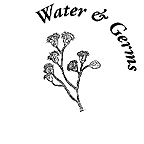
Introduction
1. What are germs?
2. Getting germs
3. Germ environment
4. Germ travel
5. Symptoms
6. Water's role
7. Water suppliers
8. Rules
9. Conclusion
Diseases & pathogens
Note on E. coli
What are germs?Do you remember the last time you were sick?
Think about your symptoms: did you throw up, have a fever, go to the bathroom frequently? How long did your illness last? Did you go to the doctor? Did anyone suggest what made you sick? Chances are very high that there were germs involved.
Germs are
everywhere in the world: on us, in us, and around us. Some of them can
make us sick, by causing infections, so doctors and scientists work hard
to learn as much as they can about them. Water suppliers need to understand
germs, too, because it is their job to keep drinking water safe.
 |
Pathogens
are
germs that cause disease. Pathos is Greek for suffering, and -gen
is a suffix meaning producer, also from Greek. Thus, "pathology" is
the study of disease, and a "pathogen" is a disease maker.
|
|
| "Germ" is a common term to describe a living microscopic creature which takes in food and gives off waste, grows, reproduces, and dies. Common types of germs are bacteria, viruses, fungi, and protozoa. Most microorganisms (also called microbes) cause us no harm, and there are many we depend upon. |
 |
See
the kinds of germs we're talking about |
Lesson
2
>
|